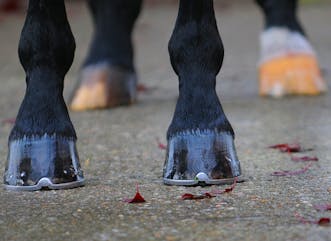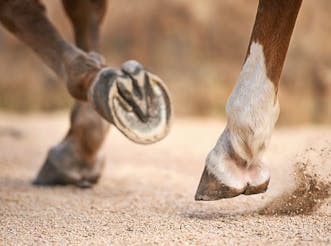
horses Hooves Info...
What Are Hooves?
- Horses have four hooves, one on each of their four legs, and their hooves are essential for their mobility and overall health. Here is some general information about horse hooves:
- A horse's hoof is made up of several layers, including the outer hoof wall, the sensitive inner layer, and the underlying bone and soft tissue structures. The outer hoof wall is made of keratin, the same material that makes up human hair and nails.
- Horses' hooves grow continuously throughout their lives, and they need to be trimmed or filed regularly to prevent them from becoming too long or brittle. Regular hoof care, including cleaning and regular visits from a farrier, is important for maintaining the health of a horse's hooves.
- Horses are "digitigrade" animals, meaning they walk on their toes (in this case, the hoof), rather than on the soles of their feet like humans do. This is why horses appear to be walking on the tips of their toes, and why their hooves need to be strong and healthy to support their weight and movement.
- Hoof-related issues, such as thrush (a bacterial infection of the hoof), abscesses, and cracks, can cause pain and lameness in horses. Regular hoof care and monitoring for any signs of issues can help prevent these problems from occurring or becoming more serious.
- There are a variety of hoof care products available for horses, including hoof boots, hoof picks, and topical treatments for conditions like thrush. Some horse owners also use supplements and dietary changes to support overall hoof health.

Horse shoes, also known as horseshoes, are protective metal devices that are attached to the bottom of a horse's hooves. The practice of shoeing horses dates back to ancient times and continues to be an essential part of equine care and management in modern times. Here's some information about horse shoes:
- what is the purpose?
The primary purpose of horse shoes is to protect the horse's hooves from wear and tear, especially on hard or rocky surfaces. Horseshoes also help to provide traction, which is crucial for horses that work on various terrains, such as those used in riding, driving, or agricultural activities.
- how is the Hoof protected?
The hooves of domesticated horses may not be as tough as those of wild horses that constantly move over varied terrain. Shoeing helps prevent excessive wear and cracking of the hooves, which could lead to lameness and discomfort.
- what are the Materials?
Traditional horse shoes are made of metal, usually steel or aluminum. However, there are alternatives available today, such as composite materials and synthetic horseshoes made of rubber or plastic. These materials may be used in certain situations, such as for therapeutic purposes or to address specific hoof problems.
- what is the shoeing process?
Shoeing a horse requires the expertise of a professional farrier (horseshoer). The process involves cleaning and trimming the hooves, shaping the shoe to fit the hoof correctly, and then nailing or gluing the shoe to the hoof wall. Correct shoeing is essential for maintaining the horse's balance and overall soundness.
- Shoeing frequency:
The frequency of shoeing depends on the individual horse's needs and the work it performs. Some horses may require shoeing every 4 to 6 weeks, while others might go longer between shoeings. Regular hoof care and maintenance are essential to monitor the condition of the hooves and shoes.
Types of horse shoes: There are various types of horse shoes designed to cater to different needs. Common types include:
- Plain shoe: A basic horseshoe without any additional modifications.
- Bar shoe: A horseshoe with extended bars on the heels for added support and stability.
- Egg bar shoe: Similar to the bar shoe, but with a rounded shape for additional support and stress relief.
- Wedge shoe: A shoe with a wedge-shaped pad to address certain hoof or leg issues.
- Aluminum shoe: Lightweight and often used for horses engaged in speed events or for horses with certain hoof conditions.
- Therapeutic shoe: Custom-made shoes designed to address specific hoof problems or injuries.
It's important to note that not all horses require shoeing. Some horses, particularly those with strong, healthy hooves and minimal workload, may go barefoot, meaning they do not wear horseshoes. Barefoot trimming and hoof care are alternative approaches to maintain hoof health for these horses

all about horses shoes...



